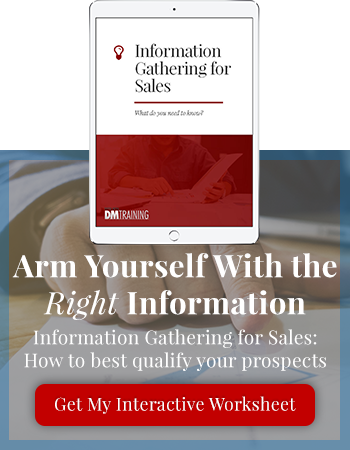How to Sell with Emotions to Win Over These Type of Customers
A sale is in many ways a performance. There are lines to rehearse (sales pitch), costumes worn (your best business wear), and even a stage (the meeting room or the phone). All of this builds up to the big performance.
But what is the end goal of any performance? What makes it truly compelling?
The emotions it elicits from the audience.
Tapping into a buyer's emotions is a powerful tool to use in your day-to-day sales approach. As a seller you should never underestimate the strength of ethos. If utilized correctly, it has the potential to turn cold calling hot, or even establish a lifelong loyal customer.
Think back to the dullest teacher you’ve ever had. Why was sitting through their class so interminable? It was likely because their presentation left you feeling absolutely nothing.
A sales rep should have a basic understanding of human psychology and how to leverage it to his or her advantage, especially considering the fact that up to 95% of our purchasing decisions are made unconsciously. This means that people tend to buy emotionally and will later justify it logically.
Not sure what you need to know about your prospects to start selling with emotion?
Get started with our interactive info gathering worksheet:
Even as communication becomes more digitally oriented, it’s still critical to stress the importance of human sentiment when building relationships and driving successful business deals.
But how do you know what will work for different types of customers?
The key to knowing which emotions to play into lies in your customer’s belief system.
We’ve put together this mini guide to provide an introduction into the art of leveraging emotions for sales success by first helping you identify which emotion should be used for which kind of customer and why. It even includes indicators to help you figure out what buyers are more susceptible to which emotions.
Customers Driven by Optimism VS. Pessimism
It’s easy to get caught up in the process of cold calling and prospecting. However, even in this preliminary stage of sales you can use emotions to your advantage.
When prospecting, you may fall into the trap of immediately launching into a series of negative questioning. For example:
- “What’s your biggest problem right now?”
- “What don’t you like about your current service?”
- “How long have you had this problem?”
These questions must eventually be addressed; however, try starting with a more positive line of inquiry from the get go. Ask questions such as:
- “Where do you see yourself (or your business) a year from now?”
- “What do you hope to accomplish?”
- “How has (x) problem affected your life?”
- “What are your biggest goals right now.”
Talking about goals and aspirations instead of frustrations will generate a more enthusiastic and productive conversation.
A positive approach means positioning your product as something that will create value in your prospect’s life. Negative thinking tends to present a product as a cure-all for your prospect’s pain points, a task that is difficult to successfully accomplish during a first meeting.
It is far easier to initially entice a prospect when your conversation convinces them that you are genuinely invested in their future and wellness.
Customers Driven by Money
In a sales interaction everyone is trying to make money.
You’re hoping to get a nice commission by closing a deal, and your customer is hoping your product will boost their own business. Therefore, a successful sale means a win-win for everyone involved.
The trick is to show this to your customers. You must emphasize and demonstrate the value of what you’re offering.
Show a potential customer the possible revenue or benefits your business could bring them. There are multiple ways to do so. Try sharing an anecdote of a former or current customer who saw significant ROI after closing a sale with you. Be sure to use money oriented buzz words such as: “revenue” “invaluable”, “profit”, or “earnings” even more than you usually would.You can identify this type of customer by looking for these indicators:
- Very ROI oriented
- Asks many questions about potential profit
- Is hesitant about the cost of a new product or service
- Eager to get to the bottom line right away
The only thing we have to fear is fear itself...unless you are a salesperson. In that case, you can use fear to drive a sale.
Fear comes off as an overly intense emotion to employ when dealing with prospects and we are not implying that you should use intimidation in your next meeting. Instead, we are discussing the more nuanced aspects of fear, the ones that heighten our senses and lead us to take action quicker than we normally would.
Ask a positive question like the ones above, “Where do you see yourself in X years?” After they share their hopes and goals for the future, use fear.
Make your prospect understand not only how your product can help them get there, but also how the cost of not acting will impact themselves and their business. You can also convey the negative consequences of inaction by sharing a story of a customer who did wait too long before turning to your company’s product or service. Make it clear that this is not a position they want to end up in. How long can their business afford NOT to act?
People are inherently wired to protect themselves; therefore, fear won’t fail to elicit a reaction.
You can identify this type of customer by looking for these indicators:
- They dislike an uncertain future
- They fear failure
- They’ve expressed doubts
Trust is the hallmark of sales success. If you want to establish a career as a an expert in your field, you better learn how to generate trust and credibility with potential customers.
This emotion is particularly unique because it cannot be faked, others can always tell when trust is disingenuous. However, in a time of fake news, reality TV, and a hard hitting recession, it can be hard knowing who to trust. As a sales rep you must actually mean what you say, and do as you promise.
Utilizing the emotion of trust is all about being open and honest.
Display your company’s transparency by offering testimonials, customer reviews, hard data, and publications you or your company have appeared in.
Try working in phrases and anecdotes such as:
- “After X years in the business we’ve helped a number of customers in your shoes…
- A brief story about yourself and a positive sales experience
- Share the human benefits of your product. How will your product enrich their personal life? How can it aid their employees?
- Emphasize all of the wonderful ways your product or service can make a prospect’s life better, but also be honest about what your product doesn’t do.
The more a prospect knows about your company and how it works, the more comfortable they will feel trusting you with their business. Trust leads to a sense of security and makes the thought of doing business appear to be a safe choice. This will not only leave the prospect with no surprises, but also gain their respect for your transparency.
Trust leads to customer loyalty, and existing, loyal customers are the key to your company’s success.
You can identify this type of customer by looking for these indicators:
- They are looking for security
- They are a critical thinker and take decision making very seriously
- They question everything
- They need reassurances like talking to a reference or seeing a testimonial
Start Using Your Emotions to Motivate Your Prospects
When talking to a prospect, your presentation should employ both sides of their brain.
The left side concerns itself with the content of what is being said, but the right side is all about how it is being said and what the message and context are behind your words. Like the old saying goes, “It’s not what you say, but how you say it.”
Don’t neglect the right brain in your next sale and play emotions to your sales advantage.
Customers who feel emotionally connected to a company or product are 52% more valuable than those who are merely satisfied. So, if you want a prospect to remember you, leave them emotionally charged.
While you’ll inevitably deal with many other types of customers and emotions, this is just a starting point to help you understand the importance of establishing an emotional connection with your prospects and customers but also keeping in mind that what appeals to one customer may not work for the other.
Use our interactive Information Gathering worksheet to help you gather the right information and start better understanding your prospective customers.
About Jennifer Clark
Jennifer Clark is a senior International Studies student at Fordham University and a Content Marketing & Social Media Intern with DMTraining. Prior to joining the DMTraining team, Jennifer helped various start-ups market themselves on and off campus. This summer, she hopes to add value to DMTraining by assisting clients with digital media education, using her status as an industry newcomer to her advantage. Outside of work, Jennifer enjoys creative writing, making art, and petting every dog she comes across.






